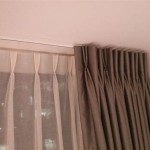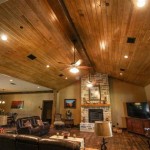Should Ceiling Color Be Lighter or Darker Than Walls? A Comprehensive Guide
The question of whether the ceiling color should be lighter or darker than the walls is a fundamental consideration in interior design. The choice significantly impacts the perceived size, shape, and overall ambiance of a room. There is no universally correct answer; the optimal ceiling color depends on a variety of factors, including room size, ceiling height, natural light availability, and desired aesthetic.
Understanding the principles of color theory and how different shades interact with light is crucial for making an informed decision. Furthermore, considering the psychological effects of color and the existing architectural features of the space is essential for achieving a harmonious and visually appealing result. Ignoring these factors can lead to a room that feels cramped, unbalanced, or simply uninviting.
This article will explore the nuances of choosing a ceiling color, outlining the advantages and disadvantages of both lighter and darker options while providing practical guidance for making the right decision for any given space.
Understanding the Visual Impact of Ceiling Colors
Color plays a pivotal role in how we perceive space. Light colors tend to reflect light, making a room feel larger and more open. Conversely, dark colors absorb light, which can make a room feel smaller and more intimate. This principle applies directly to ceilings. A light-colored ceiling will reflect more light into the room, creating a brighter and airier atmosphere. A dark-colored ceiling, on the other hand, will absorb light, potentially making the room feel cozier but also smaller and potentially lower.
The contrast between the ceiling and wall colors also influences the perceived dimensions of the room. A high contrast, such as a dark ceiling with light walls, will visually define the ceiling plane and draw attention to the room's height (or lack thereof). A low contrast, such as a light ceiling with light walls, will blur the boundaries and create a more seamless and expansive feel. It’s crucial to consider these visual effects when selecting a ceiling color.
Furthermore, the finish of the paint affects how light is reflected. Matte finishes absorb more light than glossy finishes. Therefore, a matte finish will make a dark color appear even darker, while a glossy finish can help a dark color reflect more light, mitigating some of its shrinking effect. Selecting the appropriate paint finish is just as important as selecting the color itself.
Advantages of Lighter Ceiling Colors
Lighter ceiling colors, typically shades of white or off-white, are the most common choice for several reasons. They offer several significant advantages in terms of light reflection, perceived space, and versatility.
First and foremost, light ceilings maximize the amount of light in a room. They reflect natural light from windows and artificial light from fixtures, making the space feel brighter and more cheerful. This is particularly beneficial in rooms with limited natural light or small windows. A brighter room tends to feel more inviting and less claustrophobic.
Secondly, light ceilings visually raise the height of the room. By reflecting light upwards, they trick the eye into perceiving more vertical space. This is especially advantageous in rooms with low ceilings, where a dark ceiling could make the room feel oppressive. The illusion of height contributes to a more open and airy feeling.
Thirdly, light ceilings are incredibly versatile and complement a wide range of wall colors and décor styles. They provide a neutral backdrop that allows other elements in the room to take center stage. This versatility makes them a safe and reliable choice for most rooms. Light ceilings also tend to be a more timeless choice, less prone to going out of style than bolder color selections.
Finally, choosing a lighter ceiling color simplifies the painting process. White paint typically provides better coverage than darker colors, requiring fewer coats to achieve a uniform finish. This reduces both the time and cost associated with painting the ceiling.
Advantages of Darker Ceiling Colors
While less conventional, darker ceiling colors can create a dramatic and sophisticated look. When used strategically, they can add depth, warmth, and a sense of intimacy to a space. However, they also require careful consideration to avoid making a room feel cramped or gloomy.
One of the primary advantages of dark ceilings is their ability to create a sense of intimacy and coziness. By absorbing light, they can make a large, open room feel more comfortable and inviting. This can be especially effective in bedrooms or living rooms where a warm and relaxing atmosphere is desired. Dark colors can also create a dramatic contrast with light-colored walls and furnishings, enhancing the visual interest of the space.
Dark ceilings can also visually lower the height of the room, which can be advantageous in rooms with excessively high ceilings that feel disproportionate. By bringing the ceiling down visually, the room feels more balanced and grounded. This effect can be further enhanced by painting the upper portion of the walls in the same dark color, creating a canopy-like effect.
Furthermore, a dark ceiling can effectively conceal imperfections or architectural flaws. If a ceiling has cracks, stains, or uneven surfaces, a dark color can help to camouflage these imperfections and create a more uniform appearance. This can be a cost-effective alternative to extensive ceiling repairs.
Finally, dark ceilings can be used to create a dramatic and luxurious aesthetic. When paired with sophisticated lighting fixtures and elegant furnishings, a dark ceiling can transform a room into a stylish and inviting haven. However, achieving this look requires careful planning and attention to detail.
Factors to Consider When Choosing a Ceiling Color
The decision of whether to use a lighter or darker ceiling color should not be made arbitrarily. Several factors must be carefully considered to ensure that the chosen color enhances the overall look and feel of the room.
Room Size and Ceiling Height: As previously mentioned, room size and ceiling height are crucial considerations. In small rooms with low ceilings, lighter colors are generally preferred to maximize light and create the illusion of space. In larger rooms with high ceilings, darker colors can be used to create a more intimate and balanced atmosphere.
Natural Light Availability: The amount of natural light in a room is another important factor. Rooms with plenty of natural light can generally handle darker ceiling colors without feeling too gloomy. However, rooms with limited natural light should opt for lighter colors to brighten the space.
Existing Décor and Furniture: The existing décor and furniture in the room should also influence the choice of ceiling color. The ceiling color should complement the overall color scheme and style of the room. For example, a room with light-colored walls and furniture might benefit from a slightly darker ceiling color to create a sense of depth and contrast.
Function of the Room: The function of the room should also be considered. Bedrooms and living rooms, where relaxation and comfort are paramount, can benefit from darker ceiling colors that create a cozy atmosphere. Kitchens and bathrooms, where brightness and cleanliness are important, are typically better suited to lighter ceiling colors.
Personal Preferences: Ultimately, the choice of ceiling color should reflect personal preferences. While it is important to consider practical factors, the most important thing is to choose a color that you find aesthetically pleasing and that creates the desired mood in the room.
Architectural Details: Certain architectural details can be highlighted or downplayed through ceiling color. Crown molding, for instance, can be emphasized by painting it a contrasting color to both the walls and ceiling. Conversely, distracting or unsightly architectural features might be camouflaged by blending the ceiling color with the walls.
By carefully considering these factors, it is possible to choose a ceiling color that will enhance the beauty and functionality of any room. Remember to test paint samples in the room under different lighting conditions before making a final decision. This will help to ensure that you are happy with the color and that it creates the desired effect.
Dark Ceilings With Light Walls Experts On The Pros And Cons Livingetc
4 Reasons To Paint Your Ceiling Dark De Manor Farm By Laura Janning
4 Reasons To Paint Your Ceiling Dark De Manor Farm By Laura Janning
What Color Should You Paint Your Ceiling Plank And Pillow
Anyone Have Pics Of Ceiling Darker Than Walls
Does Dark Paint Make Your Ceiling Appear Lower The Decorologist
Painting The Ceiling A Diffe Color In Living Room Yay Or Nay Decorologist
Nursery Update Why I Chose To Paint The Ceiling Dark
Paint Your Ceiling Dark And Reasons Why You Should Artsy Rule
5 Ways To Paint Your Ceiling In 2024 Big Dog Painting
Related Posts








